Adventure Tourism exploiting Blue Mountains
Friday, July 6th, 2012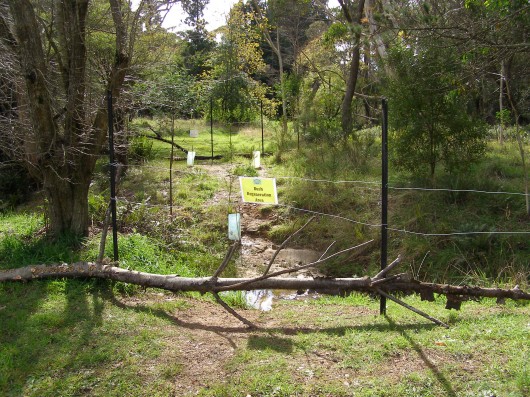 Bushcare Rehabilitation Site on a tributary of Katoomba Falls Creek
The Gully, Katoomba, Blue Mountains
This was allegedly ripped up by Blue Mountains Council to accommodate a marathon.
(click photo to enlarge)
Bushcare Rehabilitation Site on a tributary of Katoomba Falls Creek
The Gully, Katoomba, Blue Mountains
This was allegedly ripped up by Blue Mountains Council to accommodate a marathon.
(click photo to enlarge)
.
‘The Gully‘ situated in the upper central Blue Mountains of New South Wales (NSW) is a natural creek valley surrounded by the township development of Katoomba, within a corridor and upstream of the Greater Blue Mountains World Heritage Area.
This valley has a disgraceful history of forced eviction of Aboriginal people from their traditional tribal lands by Blue Mountains Council in 1957, of environmental devastation to build a race track in the 1960s, of associated deforestation and commercial tourism exploitation, followed after the racetrack’s rundown and loan default, by many years of ecological neglect.
More recently, despite the efforts of members of the local community to rehabilitate degraded areas and eroded watercourses, a new threat has emerged – ‘Adventure Tourism‘.
Back in 2008, two separate organisations – AROC Sport Pty Ltd and The Wilderness Society NSW (an organisation which should know better) decided to launch respective marathons each through the Greater Blue Mountains World Heritage Area. They each proposed their respective marathon events with the government custodian of the World Heritage Area, the NSW National Parks and Wildlife Service and since both marathon courses also involved running through community land, they also approached the custodian, Blue Mountains (city) Council.
AROC Sport Pty Ltd proposed its Ultra Marathon with UK outdoor gear sponsor The North Face which it termed ‘2008 North Face 100‘ marathon – a 10okm individual marathon along walking tracks through the Blue Mountains World Heritage Area including through the magnificent Jamison Valley. The Wilderness Society NSW proposed a similar marathon termed ‘Wild Endurance 100 Blue Mountains‘, also a 100km team-based marathon along walking tracks through the Blue Mountains World Heritage Area including the Jamison Valley. Both events were publicised as being one off events, but have since become annual events attracting hundreds of competitors and spectators.
In January 2008, The Habitat Advocate learned that these two events had already been approved by the Regional Director of NSW National Parks and Wildlife Service (NPWS NSW), Geoff Luscombe, without apparently any consultation either with the Blue Mountains community nor with any conservation groups that have for many decades had a close association with the Blue Mountains and its conservation. [BMNP POM: “A Neighbour Relations Strategy will be developed to raise awareness about the park’s significant natural and cultural values, inform park neighbours about park management programs and encourage appropriate behaviour to minimise impacts on the park. Within the City of Blue Mountains, “neighbours” will include the whole community.”]
On 20080130, The Habitat Advocate wrote to the Blue Mountains (city) Council’s then Acting Bushland Management Project Officer, Ms Arienne Murphy, explaining our concern:
“The degree of environmental protection and safeguards for these affected natural areas that Council may be imposing upon the respective event organisers, and the trend of adventure tourism and elite sporting events using natural areas of high conservation value is one that warrants appropriate environmental safeguards, monitoring and a transparent decision making process.”
.
The Habitat Advocate requested from Blue Mountains (city) Council:
- A copy of the user requirements including any standard terms and conditions that Council issues to (1) casual recreational license holders and (2) ongoing recreational license holders of Council-managed/controlled natural areas in the Blue Mountains Local Government Area.
- A copy of the specific operating terms and conditions relating to the proposed Northface 100 and Wild Endurance marathon events both due to take place around Nellies Glen and through the Jamison Valley wilderness in May 2008.
.
The correspondence was ignored by Council and no information was received from Council.
At the time, The Habitat Advocate also raised similar concerns about the risks of damaging ecological impacts and of the unsuitability of these two events through the World Heritage Area with interested representatives of conservation groups – The Colong Foundation for Wilderness, the Blue Mountains Conservation Society, the National Parks Association of NSW, and the Nature Conservation Council of NSW.
Issues raised included:
- To examine and improve the rule that regulate these events
- To identify the location of high conservation value natural communities that the routes of each event propose to pass through
- How the responsible custodian (NPWS NSW) proposes to ensure these communities are not adversely impacted
- To protect and defend the important natural values of the Blue Mountains and the rare and threatened habitat of its flora and fauna.
- The hold the NPWS NSW as custodian of the Greater Blue Mountains World Heritage Area to account under the Blue Mountains National Park Plan of Management (May 2001) [BMNP POM]and in accordance with its mottos of ‘tread lightly’ and ‘take only photos and leave only footprints’.
- Ensure protection of wilderness values and adherence to a wilderness code of conduct to ensure “minimal impact codes or practices for potentially high impact activities
including cycling, horse riding, adventure activities and vehicle touring” [BMNP POM, p.52]
.
A meeting was held at the office of the Colong Fondation in Sydney on Wednesday 20080206 between The Habitat Advocate, the above conservation groups and with Geoff Luscombe as well as with The Wilderness Society. The above concerns were raised with Mr Luscombe and he politely gave assurances that both events would not cause damage to ecology. The key document that would guide the conduct of the events and protect the ecology was the then ‘Interim Policy for Commercial Recreational Activities in National Parks of the Blue Mountains Region‘ (dated 20070926), by the then umbrella department of NSPW NSW, The Department of Environment and Climate Change.
However, no specific recognition, rules or guidelines were made to allow for commercial marathons involving large numver of participants and spectators within either the Interim Policy for Commercial Recreational Activities in National Parks of the Blue Mountains Region nor within the Blue Mountains National Park Plan of Management.
Indeed the Interim Policy includes clauses that run counter the large scale of two such commecvial marathons as per the following extract clauses:
.
‘Environmental Protection’:
.
Clause 5.1.11: “Commercial activities will not be permitted to lead to permanent or unsustainable impacts on the resource or become a significant proportion of visitor impact on a site or area.”
.
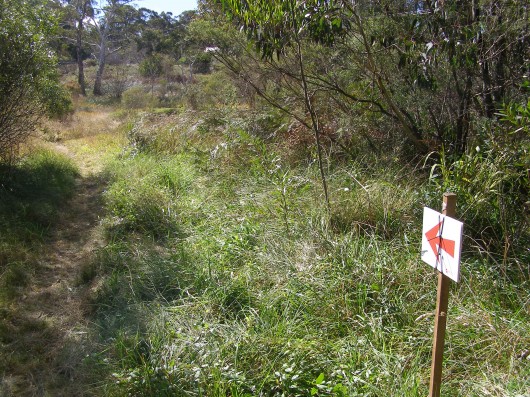 Slashed vegetation for the marathon through The Gully’s swamp, Katoomba
But what is the impact is occurring upon flora deep in the Jamison Valley Wilderness?
Who monitors the marathons? Who is the watchdog over the custodian?
Slashed vegetation for the marathon through The Gully’s swamp, Katoomba
But what is the impact is occurring upon flora deep in the Jamison Valley Wilderness?
Who monitors the marathons? Who is the watchdog over the custodian?
.
Clause 5.1.13 “The current Minimal Impact Bushwalking Code (Australian Alps National Parks) should be used by operators/guides as a minimum code of behaviour for all activities.”
.
[Ed. But under NPWS NSW Activity Agreement with AROC Sport, AROC Sport needs only..”Use best endeavours to ensure that participants adhere to the approved route on recognised and approved fire trails and walking tracks within the Park and do not deviate from these trails and tracks at any time.”]
.
Clause 5.1.14 “No modification to the environment, permanent or temporary, will be permitted (eg. fixtures or temporary caches) without specific Department approval.”
[Ed. So where is the NPWS NSW monitoring of compliance, or lack thereof?]
.
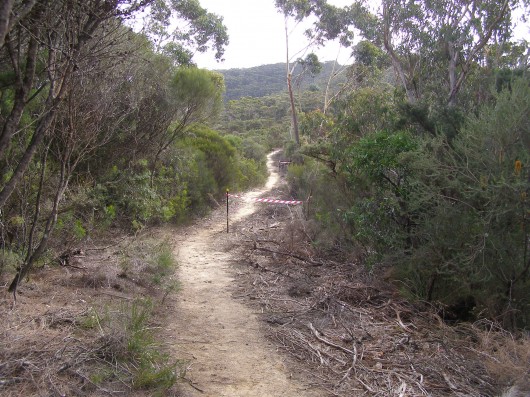 Cliff Walk slashed along the top of the Blue Mountains Western Escarpment
to accommodate the North Face 100 marathon in 2008
Cliff Walk slashed along the top of the Blue Mountains Western Escarpment
to accommodate the North Face 100 marathon in 2008(Photo by Editor 20080517)
.
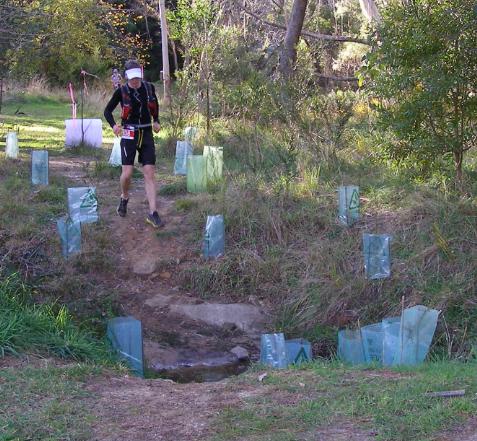 North Face 100 participant runs through a Gully Bushcare Site, previously fenced off and sign posted
This riparian area was disturbed by Sydney Water in 2007 during its Sewer Amplification Project.
The site was subsequently rehabilitated with native plants by Networks Alliance in co-operation with local coucil and the local buschare group.
North Face 100 participant runs through a Gully Bushcare Site, previously fenced off and sign posted
This riparian area was disturbed by Sydney Water in 2007 during its Sewer Amplification Project.
The site was subsequently rehabilitated with native plants by Networks Alliance in co-operation with local coucil and the local buschare group.
.
‘Recreation Management’:
.
Clause 5.1.21 “Commercial activities can only form a minor component of total use and not lead to the domination of a particular setting, site, route or activity, or unreasonably restrict or exclude the recreational opportunity of other users.”
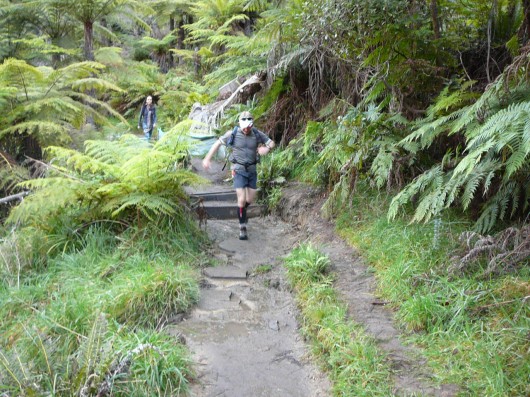 Runners take right of way over bushwalkers
What happens when the marathons are required to stay together in teams?
Runners take right of way over bushwalkers
What happens when the marathons are required to stay together in teams?
.
Clause 5.1.22 “Acceptable levels of use, in relation to the conservation and protection of the environment, will be based on precautionary principles determined by the Department and this process may not maximise commercial opportunities.”
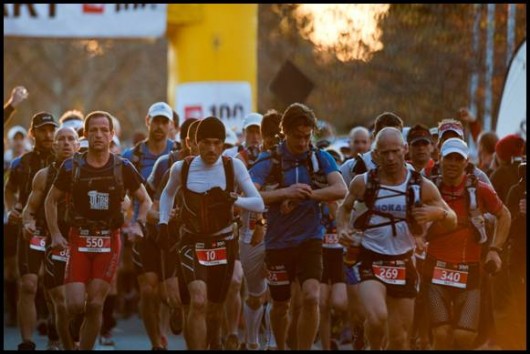 Northface100 competitors – 1000 registered entrants an “acceptable level of use”?
Northface100 competitors – 1000 registered entrants an “acceptable level of use”?
.
‘Appropriate Activities’:
.
Clause 5.1.25 “Activities resulting in minimal impact will be preferred over those causing greater impact (eg. track walking versus off-track walking).” [Ed. No mention here about commercial marathons involving hundreds of participants]
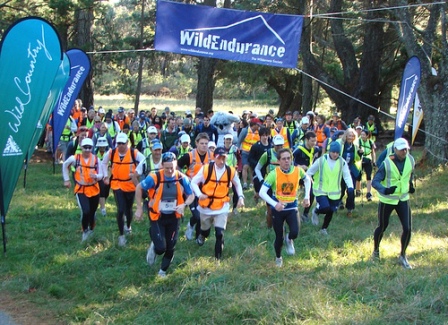 Does my team have to stick together over the entire length of the trail?
Does my team have to stick together over the entire length of the trail?Wild Endurance: Yes. It is compulsory for the whole team to stay together the whole time. The team must arrive together and depart from each Checkpoint and also cross the finish line together. Of course if you are in the Relay event, then only half the team needs to arrive at each checkpoint and cross the finish line together.
.
.
Clause 5.1.27 “Where impacts associated with activities are high and sites are deemed suitable for recreational purposes, sites may be managed by the Department to provide for intensive use.” [Ed. No mention was made by Luscombe about any monitoring and enforcement by NPWS NSW]
.
Revisiting the Blue Mountains National Park Plan of Management:
.
- The Service will continue to develop its Discovery interpretive program, including investigation of options for improving the quality, quantity and geographic spread of activities offered
- The emphasis will continue to be on environmental interpretation and education and away from hard adventure.
- Recreation Opportunities: Use by domestic and international tourists is largely day use concentrated on the scenic escarpment areas of the Jamison and Grose valleys, from Wentworth Falls to Katoomba and at Blackheath, although other relatively easily accessible areas are popular for adventure ecotourism (see section 4.3.8 Guided Tours and Commercial
Recreation). - With tourism in the Blue Mountains region projected to increase strongly over the next five years, the need to minimise the impacts of tourism on the natural environment is a growing concern.
- Recreation use of the park includes a wide range of activities and is distributed throughout the park…Use is distributed throughout the year, with peaks during school holiday periods and long weekends.
- The park is under increasing pressure from the growing number of park visitors, with some popular bushwalking and camping areas such as the Grose Valley, Wollangambe
area, the Wild Dog Mountains, Burralow Creek, Erskine Creek, Glenbrook Creek, Ingar and Murphys Glen showing signs of unacceptable environmental impacts. - Adventure activities such as canyoning, abseiling and rockclimbing have increased dramatically in 56 popularity, with visitation to one popular canyon having doubled over a two year period. These activities are associated with a proliferation of informal foot tracks which are eroding with increasing use. Vegetation is being denuded at popular abseiling and/or rockclimbing access points and public safety is an issue at some sites, particularly where there is conflict with other users.
- Major management considerations include the need to raise awareness of visitor impacts, to monitor visitor use and, where necessary, to regulate visitor numbers to
protect the park environment, ensure visitor safety and maintain recreation experiences appropriate to a natural or wilderness setting. - Regulation of large groups, commercial activities and adventure activities needs to be considered in relation to both environmental impacts and public safety. Use of the park
by larger groups has the greatest potential to impact on the park. User conflicts, risks of accidents and injuries and impacts on natural and cultural heritage values all rise in
proportion to the size of the group. - The existing facilities have been developed over a period of more than a hundred years and are not necessarily compatible with existing design, safety and maintenance standards, may be having an unacceptable environmental impact and/or are inadequate to satisfy existing or projected recreation and tourism demand and patterns of use.
- A major review of existing facilities is required and clearer priorities for maintenance and
upgrading of facilities or removal need to be developed to ensure that conservation and
recreation objectives can both be met in a management environment of limited
resources. - Natural areas: Recreation tends to be more dispersed and any facilities provided are relatively low-key compared to the developed areas, catering for a lower level of use.
- Wilderness areas: This setting provides opportunities for solitude and self-reliant recreation.
- Competitive activities including rogaining and orienteering will not be permitted in wilderness areas.
“The nominated area has a complicated border, defined partly by adjoining privately owned lands which, in the Blue Mountains Park section, also divides it into northern and southern sections along the corridor of the Great Western Highway. The heart of each Park is reserved as wilderness which totals 54% of the nominated area. ”
[Source: ‘Greater Blue Mountains (world heritage) Area’, United Nations Environment Programme, World ConbservationMonitoring Centre ].
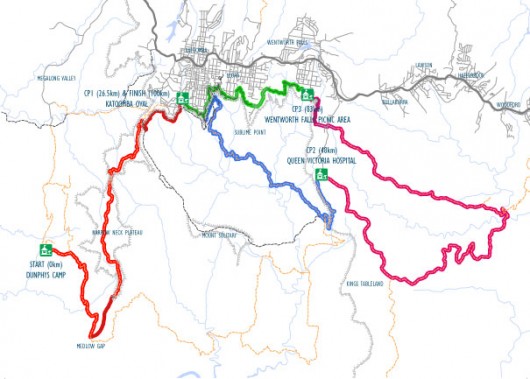 The ‘Wild Endurance’ course map passes through the Jamison Valley Wilderness
The ‘Wild Endurance’ course map passes through the Jamison Valley Wilderness
.
.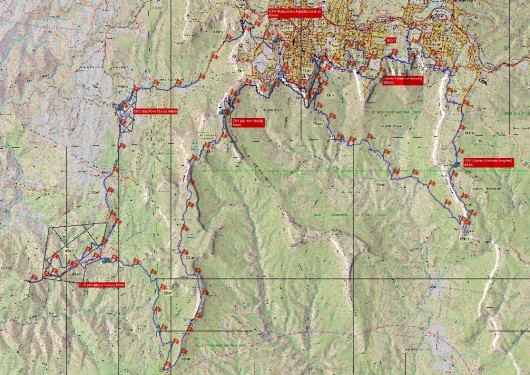 ‘NorthFace 100’ marathon course map passes through the Jamison Valley Wilderness
“Saturday 19th May 2012: The 5th Annual North Face 100 will begin at Leura’s Fairmont Resort in the Blue Mountains Australia.
Some 900 runners will embark on a 100km trail race which will take them through Jamison Valley, Narrowneck Plateau, Megalong Valley…”
‘NorthFace 100’ marathon course map passes through the Jamison Valley Wilderness
“Saturday 19th May 2012: The 5th Annual North Face 100 will begin at Leura’s Fairmont Resort in the Blue Mountains Australia.
Some 900 runners will embark on a 100km trail race which will take them through Jamison Valley, Narrowneck Plateau, Megalong Valley…”







